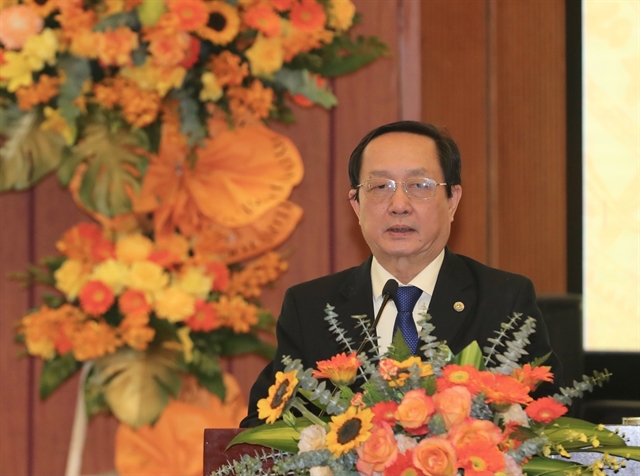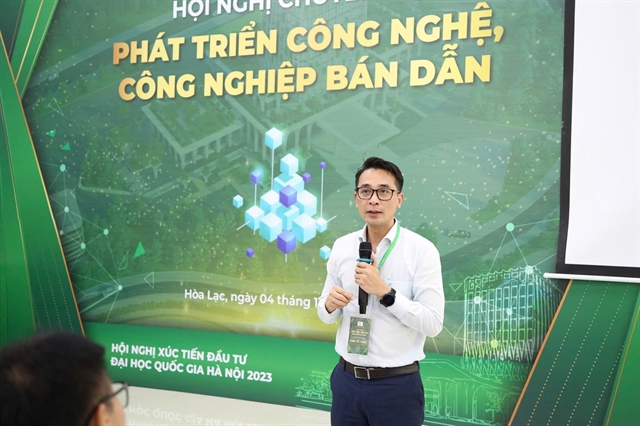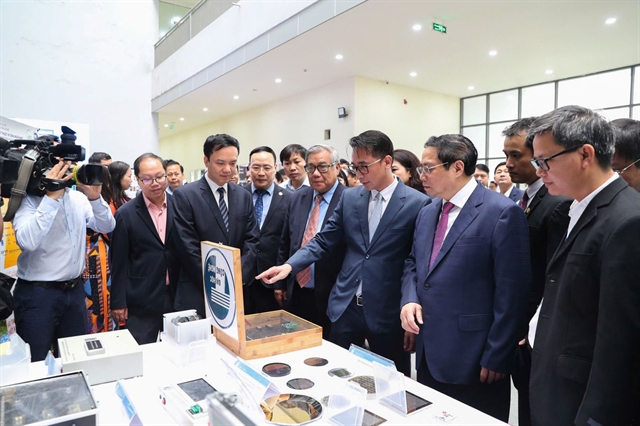 Politics & Law
Politics & Law

 |
| Professor Chử Đức Trình, rector of the University of Engineering and Technology.— Photo courtesy of Chử Đức Trình |
Professor Chử Đức Trình, rector of the University of Engineering and Technology (UET) under the Việt Nam National University, Hà Nội, discusses with the Tin tức (News) newspaper the crucial role of young scientists, who are Communist Party members, in the advancement of science and technology.
--------
On December 22, 2024 General Secretary Tô Lâm of the Communist Party of Việt Nam (CPV) promulgated a resolution called "Resolution 57" of the Politburo to make a breakthrough in national scientific and technological development, innovation and digital transformation. How has this been carried out at the UET and how will it be further expanded on in the near future?
As a manager of a technology and engineering training institution, I highly appreciate the Party and Government’s resolve in promulgating Resolution 57, positioning science and technology as a key factor in the socio-economic development of Việt Nam. It underscores the need for science and technology to become a pillar and driving force for economic growth. This is entirely consistent with the conditions, culture as well as the intelligent and hardworking nature of the Vietnamese people.
Our country will face limited opportunities for development unless we leverage science and technology. This is a lesson learned by many nations around the world. Numerous studies have shown that the labour productivity of Vietnamese workers is ten times lower than that of workers in Singapore or Malaysia. This is not the individual capacity of workers but the cumulative productivity of the entire system. If we examine the productivity of a business, we must consider a variety of factors such as the company’s organisation, product range, market positioning, investment market share and then the productivity of the workforce.
For instance, when producing electronic components, some companies generate higher profits than others because high-profit enterprises have brought knowledge and skills in the process of design, manufacturing, participating in stages with higher added value. Meanwhile, our enterprises are still relying on stages with low added value, so their income is lower.
General Secretary Lâm reckoned that Việt Nam needs to participate in higher-value stages within industrial chains. This will likely be a key factor in the breakthrough of our industries.
More than a year ago, during the Dutch Prime Minister’s visit to Việt Nam, the message he conveyed was to elevate the position of Vietnamese enterprises in the global value chain, rather than attempting to control the entire industrial chain. In today’s world, few companies build models that dominate or participate in every stage of the industrial value chain.
Resolution 57 demonstrates that we must mobilise the entire political system, the Government, all ministries and sectors to engage in building, issuing and implementing institutional policies and regulations to enhance the role of science and technology as well as research and development within the industrial system.
Resolution 57 provides a solid institutional foundation for businesses to confidently invest in the long-term development of technological products with a global market perspective. It will be the driving force to mobilise and fully exploit the involvement of stakeholders in investing and developing scientific and technological products, particularly in high-tech industries.
Only when universities and research institutes recognise the importance of their scientific research in the development of industrial products and when businesses see the high-profit potential in collaborating on research and development with these scientific institutions, can Việt Nam’s industries secure a significant place on the global stage.
This is the mission laid out in Resolution 57 for all stakeholders, including policymakers, businesses, universities and research institutes. Businesses need to invest heavily to enhance the technological value of each product to support research and development efforts, innovate new product values and increase the product's value within the global value chain.
In my opinion, higher education institutions will need to carry out the following key tasks:
First, universities must improve the quality of training programmes and the quality of graduates to meet higher requirements when participating in the value chain of enterprises. Second, universities must train students in knowledge and skills in research and development to be ready to integrate into the business environment immediately after graduation. Third, schools must build their own working culture to develop into research universities.
The UET has been autonomous for three years. We clearly realise that the university can only develop when training is combined with scientific research. The school has a number of policies to accompany research groups, teachers and student groups. It supports teachers and research groups based on research results, and directly invests in research groups through direct support based on scientific results such as scientific articles and inventions.
The policy has partly created a very good motivation in research groups. Therefore, the school's scientific and technological research achievements in the past few years have achieved a high growth rate.
In 2024, the UET had nearly 400 domestic and international articles. On average, each teacher has about 2.4 scientific articles in the Institute of Scientific Information (ISI) and Scopus categories each year.
Many of the school's lecturers are leading scientists in the country and in the world. The school has had many cooperation projects in human resource training, research and development with domestic and international enterprises such as Samsung, LG, Viettel, VNPT, Dai Nippon Printing, McNEX, Giaohangtietkiem, FPT, and Toshiba.
Recently, the UET has had two policies with highlights in science and technology, consisting of the model of investing in basic-level scientific research topics and the model of postgraduate training. The university is piloting the investment in a number of basic-level topics with an implementation period of three to five years and a budget of up to several billion đồng each year.
 |
| Prime Minister Phạm Minh Chính (2nd, right) visits the display of products of Việt Nam National University, Hà Nội, in Hòa Lạc campus on the outskirts of Hà Nội. Photo courtesy of Chử Đức Trình |
What role do young scientists-Party members play in carrying out Resolution 57?
Young scientists are extremely important and are the focal point of the university’s policies. Most of the young scientists at the UET have a PhD at prestigious universities worldwide. Furthermore, being part of the younger generation, they are highly approachable and work well with students. The young lecturers serve as a bridge between students, postgraduates, doctoral candidates and the global scientific community. Young researchers are the driving force behind the development of the university.
The university’s CPV committee always has policies in place to nurture and recruit new members from young scientists. We believe that they are the 'red seeds' in building a leading scientific workforce for our country in the years to come. The individuals will play key roles in the governance system, leadership at various levels and guide technology enterprises to align with the Party’s directives in implementing Resolution 57.
How has your university attracted pioneering young scientists to participate in Party building?
Attracting and building a high-quality workforce is a long-term policy. Today’s young scientists are the foundation and future of the university in the medium and long term. The young scientists are representatives of a very talented generation. Their understanding, experience and shared insights into political and social policies will elevate the social and national responsibility of each individual scientist.
Recently the UET has fully implemented the model of comprehensive Party leadership, tied to the practical demands of the university’s development. The university defines its lecturers' primary tasks as excelling in scientific research, teaching and leading students with responsibility and dedication, ultimately creating a positive atmosphere that produces high-quality graduates on time.
Currently, more than 60 per cent of the Party members at the university are young scientists, students and postgraduates. The Party members clearly understand their roles and responsibilities, demonstrating autonomy in their activities within the university.
How has the university fostered creativity, responsibility and accountability within its faculties and Party members to advance scientific and technological innovation and digital transformation?
With the context of university autonomy, the UET encourages each department, faculty staff member and student to exhibit independence and ownership. University autonomy allows departments, lecturers and staff to be more creative and proactive in fulfilling their tasks. Accompanying the autonomy is the responsibility to achieve results, which ultimately enhances the benefits for all stakeholders. This boosts the income of staff and increases learning opportunities, thus raising the quality of graduates.
The UET has recently developed and implemented a new internal spending regulation. We aim for staff members to receive salaries comparable to those of universities, industrial enterprises and even FDI firms in Hà Nội and surrounding provinces. We aim to offer salaries that match the standards of personnel working in research and development offices at FDI companies. This creates a fair competition in attracting talent between the university and other units or businesses.
The UET’s management system is continually innovating to maximise the potential of each faculty member, lecturer and student. We consistently align with society with our educational philosophy of "Creativity and nurturing the humanistic value of technology".
We train and cultivate each student to become a skilled scientist, technologist or engineer, while fostering a dedicated work ethic and a humanistic attitude in building a brighter future for the community, businesses, institutions and the nation as a whole. VNS